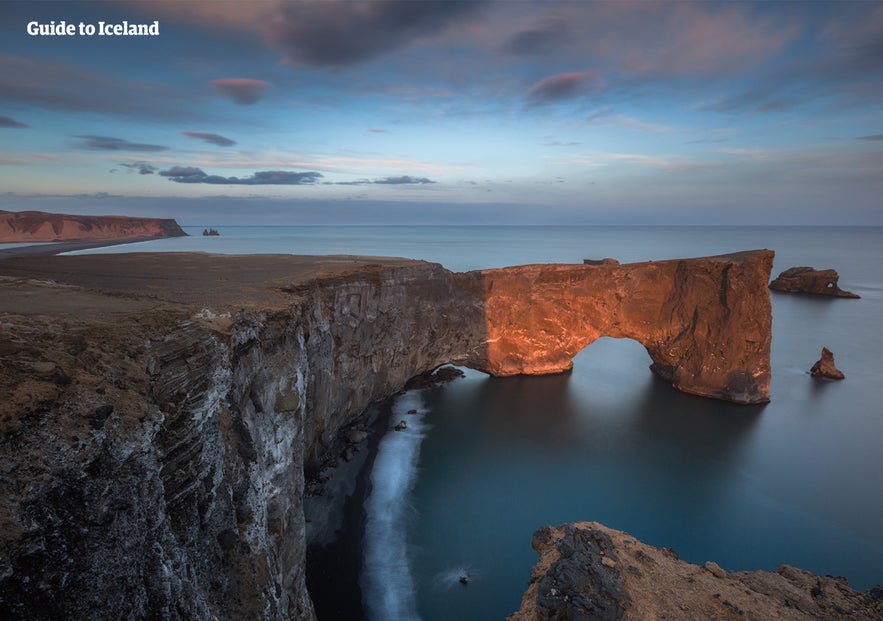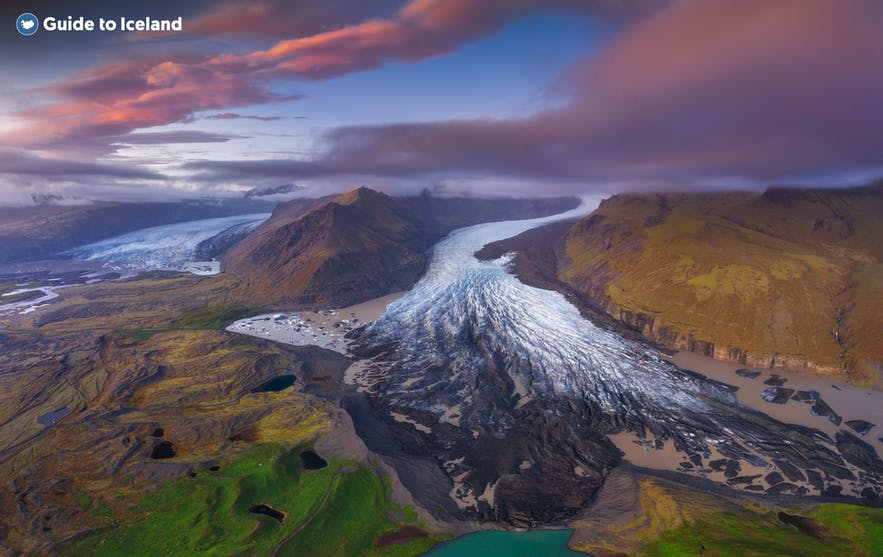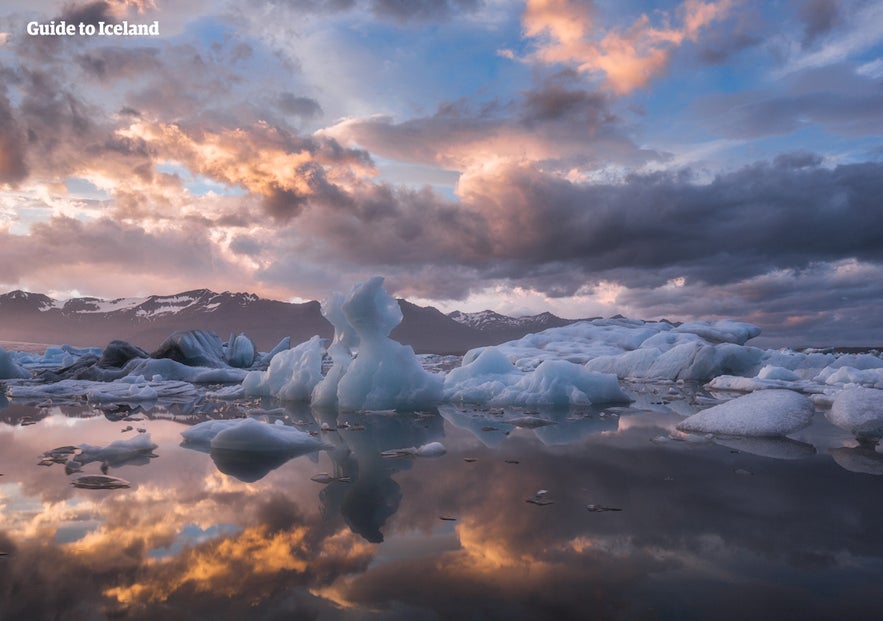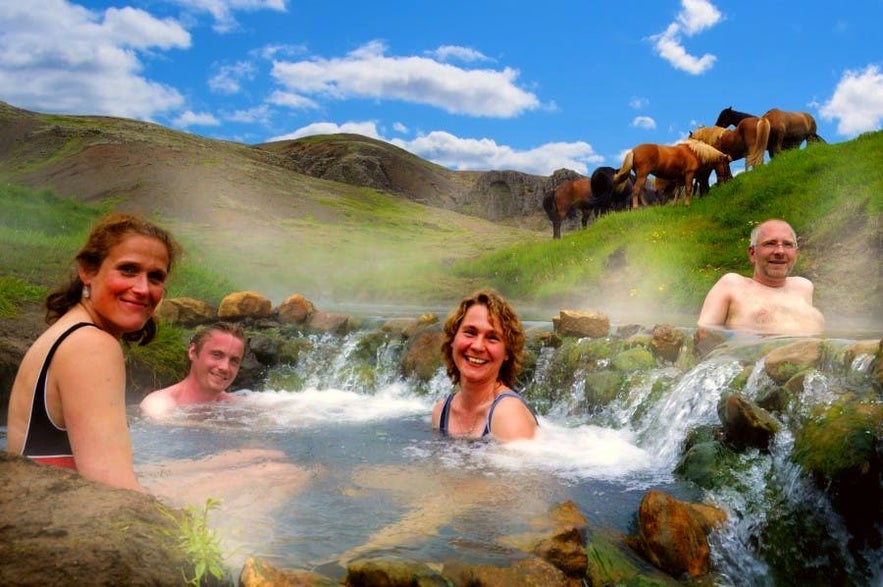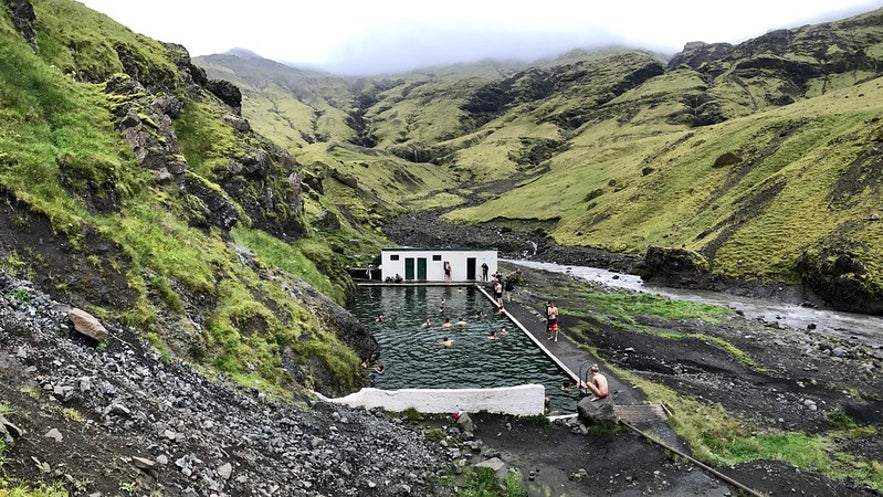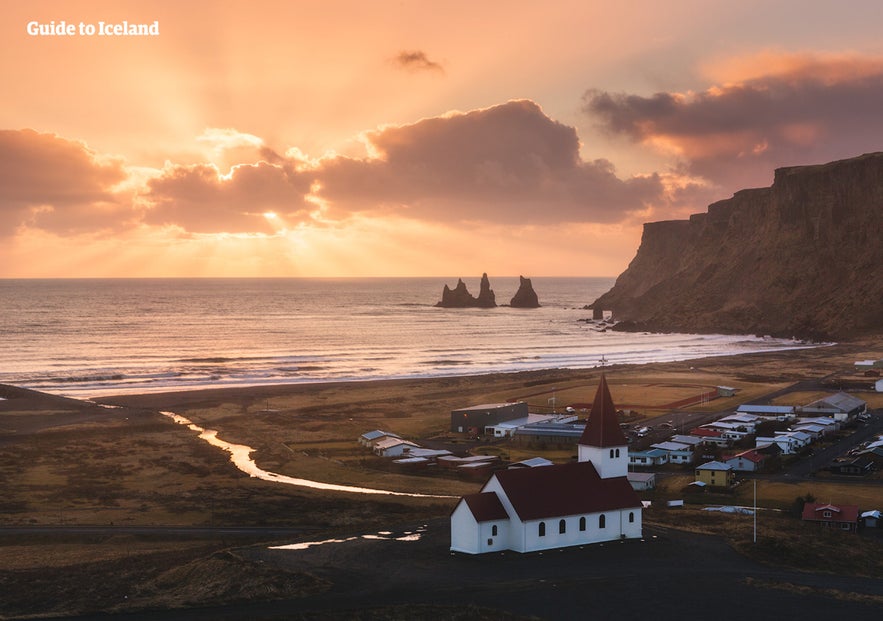
The Ultimate Guide to Iceland's South Coast
- Exploring Iceland's South Coast
- Must-See Highlights on Iceland's South Coast
- Seljalandsfoss Waterfall
- Skogafoss Waterfall
- Solheimajokull Glacier
- Dyrholaey Peninsula
- Reynisfjara Black Sand Beach
- Skaftafell Nature Reserve
- Vatnajokull National Park
- Jokulsarlon Glacier Lagoon
- Diamond Beach
- Hidden Gems Along the South Coast
- Reykjadalur Valley
- Seljavallalaug Outdoor Pool
- DC-3 Plane Wreck in Solheimasandur
- Fjadrargljufur Canyon
- Dverghamrar (“Dwarf Cliffs”)
- Charming Towns to Visit on the South Coast
- Selfoss New Old Town
- Vestmannaeyjar (Westman Islands)
- Vik i Myrdal Village
- Kirkjubaejarklaustur Village
- Hofn i Hornafirdi
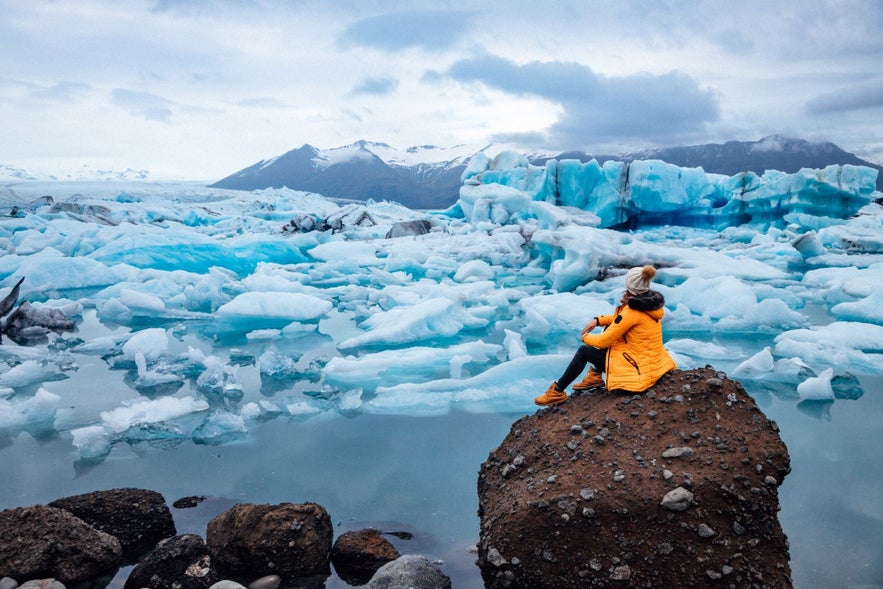
Iceland’s picturesque South Coast is one of the most popular regions for visitors to the country, and for good reason. It showcases some of Iceland’s most iconic natural attractions, including the world-famous Jokulsarlon glacier lagoon, often called "The Crown Jewel of Iceland," the vast Reynisfjara black sand beach, and the breathtaking Vatnajokull National Park.
Travelers along this stunning coastline are treated to a feast for the senses, with endless lava fields, towering cliffs, and charming fishing villages dotting the landscape. South Iceland is a haven for outdoor enthusiasts, offering activities like hiking, paragliding, Super Jeep tours, and sightseeing.
For an unforgettable experience, consider a top-rated winter ice cave tour in Vatnajokull or a fantastic 35-minute summer boat tour in Jokulsarlon, both showcasing the region's unique natural wonders during different seasons in Iceland.
Visitors can explore this remarkable region through guided tours or by renting a car in Iceland for a self-drive adventure with no shortage of unforgettable sights and experiences. It's highly recommended to book your accommodation on the South Coast in advance, as hotels in this popular area tend to sell out quickly, especially during the peak summer months.
Discover everything you need to plan an unforgettable South Coast adventure in Iceland. Read on for the best tips and insights to make this journey the highlight of your trip!
- See also: Best Attractions by the Ring Road of Iceland.
Exploring Iceland's South Coast
The South Coast of Iceland is one of the most captivating and diverse regions in the country, offering a stunning mix of dramatic landscapes, exciting activities, and rich cultural heritage. With towering waterfalls, expansive glaciers, black sand beaches, and quaint fishing villages, this region is packed with unforgettable experiences.
Driving from Reykjavik to the South Coast’s iconic Jokulsarlon glacier lagoon, the furthest popular destination, typically takes four to five hours under good weather and road conditions, without stops.
Spanning approximately 236 miles (380 km), the journey time can vary based on weather, road conditions, and how often you stop to take in the sights. Given the South Coast’s incredible attractions, many travelers opt to spread the trip over two to three days or more to fully enjoy the region’s beauty.
For those planning a self-driving round trip back to Reykjavik, don’t forget to account for the return drive and plenty of exploration time. Alternatively, you can extend your adventure by continuing East along Iceland's Ring Road for even more unforgettable experiences.
Alongside the iconic Golden Circle, the South Coast is one of the most popular regions to explore in Iceland. Whether you’re an adventure seeker, a nature enthusiast, or simply in search of breathtaking scenery, the south of Iceland has something to captivate every traveler.
Read on to find everything you need to know to plan the ultimate South Coast journey, including must-visit attractions, top activities, and main towns and villages to make your adventure nothing short of extraordinary.
Must-See Highlights on Iceland's South Coast
The South Coast of Iceland is filled with incredible attractions that every traveler arriving in the country should experience. Whether you join a guided South Coast tour or drive along Route 1 at your own pace, this scenic journey is packed with unforgettable highlights. Read on to discover the must-see stops along the way:
Seljalandsfoss Waterfall
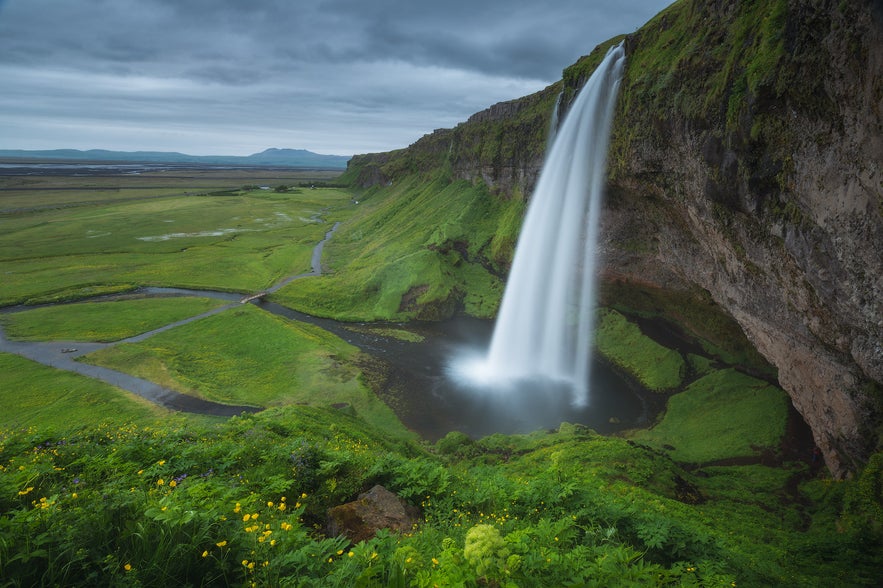 Seljalandsfoss waterfall is considered an iconic stop on the South Coast sightseeing route, in large part due to the fact that visitors can actually walk behind the cascading water here. This makes the feature particularly beloved by nature photographers who jump at the chance to snapshot the waterfall from behind.
Seljalandsfoss waterfall is considered an iconic stop on the South Coast sightseeing route, in large part due to the fact that visitors can actually walk behind the cascading water here. This makes the feature particularly beloved by nature photographers who jump at the chance to snapshot the waterfall from behind.
Standing at an impressive 197 feet (60 m) high, Seljalandsfoss is one of Iceland's most iconic waterfalls. Its water originates from the volcanic glacier Eyjafjallajokull, a name many recognize due to its 2010 eruption. This eruption not only disrupted European air traffic but also played a pivotal role in sparking Iceland's tourism boom.
Visitors to Seljalandsfoss will often continue north along the trail until they discover Gljufrabui waterfall, another small cascade hidden away inside of a gorge in these ancient sea cliffs. Once again, photographers jump at the chance to photograph Gljufrabui and its unique surroundings.
Join a magnificent south coast tour on a small bus from Reykjavik and visit this iconic landmark along with other must-see attractions along the south. You can also opt to explore this beautiful waterfall at your own pace in this one-week self-drive tour along the south of Iceland.
- See also: Top 20 Beautiful Waterfalls of Iceland.
Skogafoss Waterfall
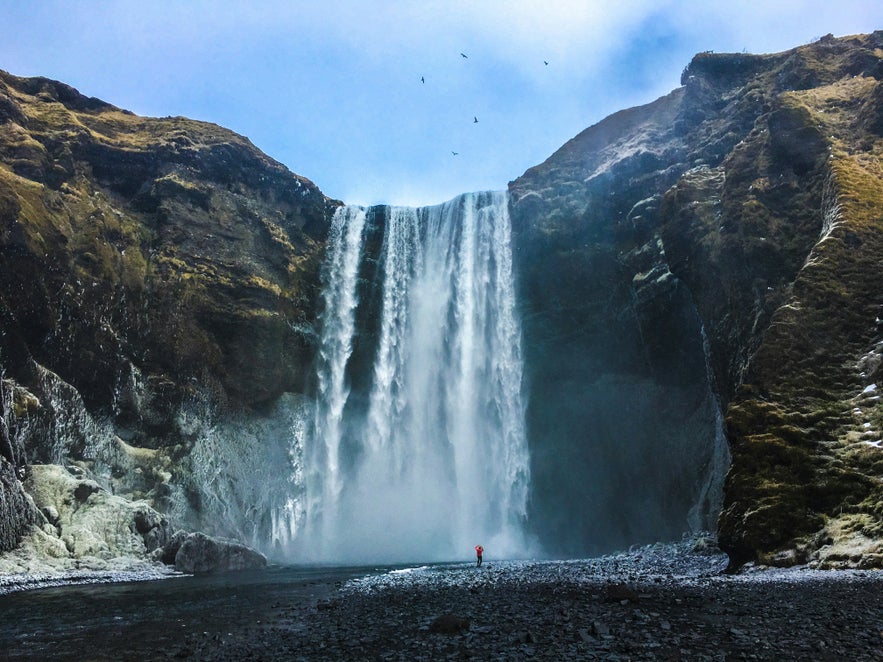 Skogafoss is one of the largest waterfalls in Iceland, boasting a drop of 196 feet (60 m) and a width of 49 feet (15 m), and it's one of the major attractions along the South Coast.
Skogafoss is one of the largest waterfalls in Iceland, boasting a drop of 196 feet (60 m) and a width of 49 feet (15 m), and it's one of the major attractions along the South Coast.
Visitors to Skogafoss can walk right up to where the cascading water crashes into the ground, making for fantastic photographs. Photos are made even more amazing by the sheer size of the mist and spray clouds constantly formed by the waterfall, creating rainbows in the light.
Standing in such proximity also allows you to experience the sheer power of this natural feature. Be careful during the winter months, however, as the rocks at the base of Skogafoss often become incredibly icy, making it dangerous to approach.
It is also possible to view the waterfall from the top if you ascend the staircase right beside it. Be careful in the winter months, however, as these stairs become laden with snowfall, making accessibility difficult.
Because Skogafoss is found a short distance from Seljalandsfoss, the waterfalls are often paired together in travel guides and considered cousins. Like Seljalandsfoss, Skogafoss has made numerous appearances in the media, including on the History Channel’s "Vikings" and in the film "The Secret Life of Walter Mitty."
- Check out Movie Locations in Iceland: The Complete List.
- See also: Top Activities in Iceland for Adrenaline Junkies.
Solheimajokull Glacier
A short drive along a gravel road on the left-hand side of the Ring Road takes you towards Solheimajokull glacier. This is the meeting place for anyone looking to do a glacier hike on this impressive glacier, which is a part of the larger Myrdalsjokull glacier.
Embarking on a glacier hike is a thrilling way to experience Iceland's natural beauty, and it's essential to do so with a certified guide for safety. Glaciers are fascinating but complex landscapes with hidden crevices and unique challenges that require expert navigation.
Every participant on a glacier hike is equipped with all the necessary gear, including crampons, helmets, and ice axes, ensuring a safe and enjoyable adventure.
For those new to this exciting activity, don’t miss the chance to join this amazing glacier hike tour for beginners, which is perfect for experiencing the magic of Iceland's icy terrain in the safest and most memorable way.
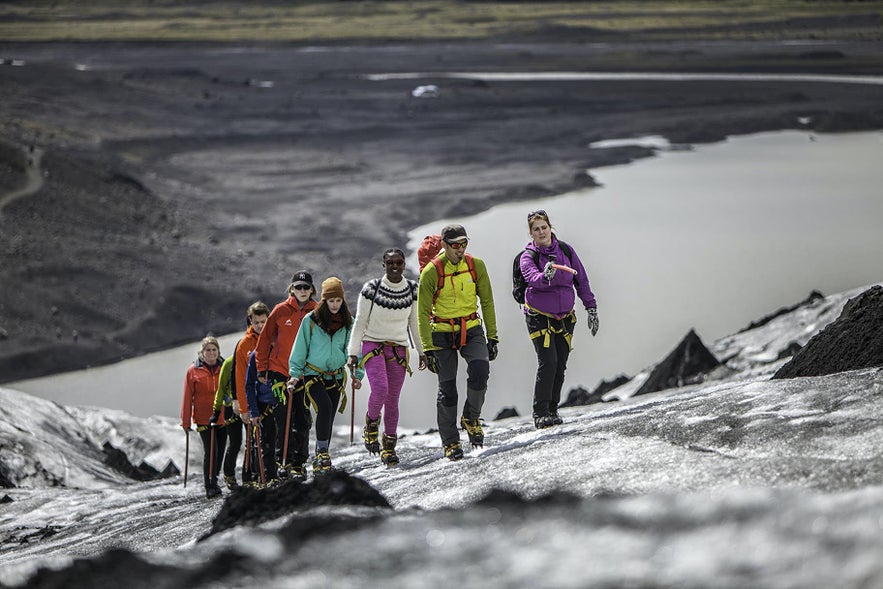 However, if you aren't looking to go on a hike on the glacier, it's still a beautiful sight to see from a distance. From the parking lot, there's a 15-minute walk to the edge of the glacier tongue, along impressive mountains and the glacier lagoon nesting in front of it.
However, if you aren't looking to go on a hike on the glacier, it's still a beautiful sight to see from a distance. From the parking lot, there's a 15-minute walk to the edge of the glacier tongue, along impressive mountains and the glacier lagoon nesting in front of it.
Dyrholaey Peninsula
Dyrholaey’s origin story can be traced back to when it was a volcanic island separate from mainland Iceland. Today, Dyrholaey is connected to the rest of the country, becoming a small peninsula unto itself.
This promontory is best known for its fantastic views over Iceland’s South Coast, as well as the birdlife that utilizes Dyrholaey’s towering cliff faces and the enormous rock arch that dominates the scene.
Those traveling to Dyrholaey for the views will be in for a sure treat. To the north, you will be able to see Myrdalsjokull glacier, while to the east and west, respectively, you will have views over Reynisdrangar and the southern coastline towards the town of Selfoss.
Do note, however, that parts of Dyrholaey are closed off during May and June in order to leave the nesting birds undisturbed. Guests looking to see birdlife can see a variety of species, including puffins, but be aware of the Arctic Tern, which is known to divebomb aggressively when protecting its nests.
- See also: Dyrhólaey - The Arch with the Hole.
- Read more about Wildlife and Animals in Iceland: The Complete Guide.
Reynisfjara Black Sand Beach
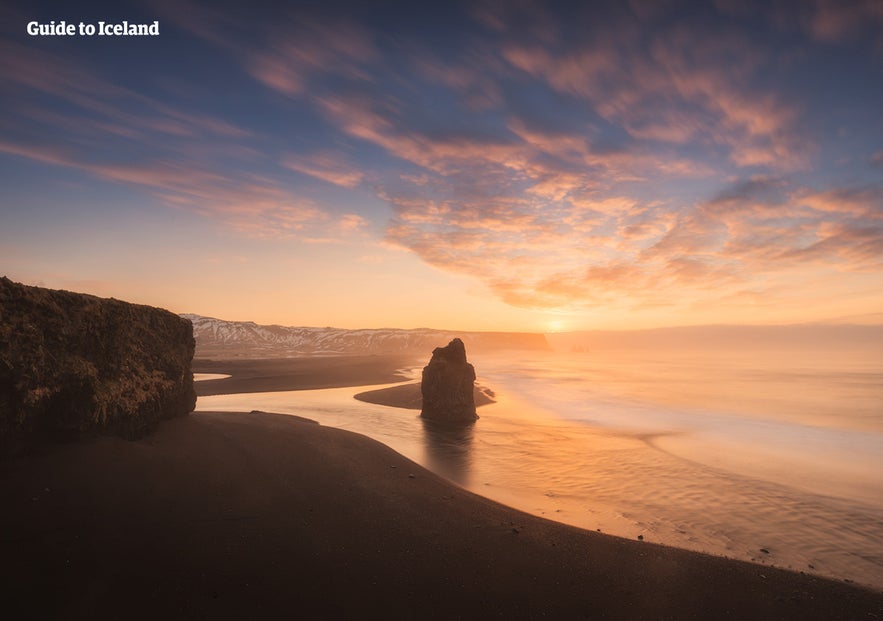
Visitors can marvel at this ancient and mystical landscape, characterized by distant mountain vistas, dramatic cliffs, and striking rock formations. In 1991, National Geographic recognized Reynisfjara as one of the world's Top 10 most beautiful non-tropical beaches.
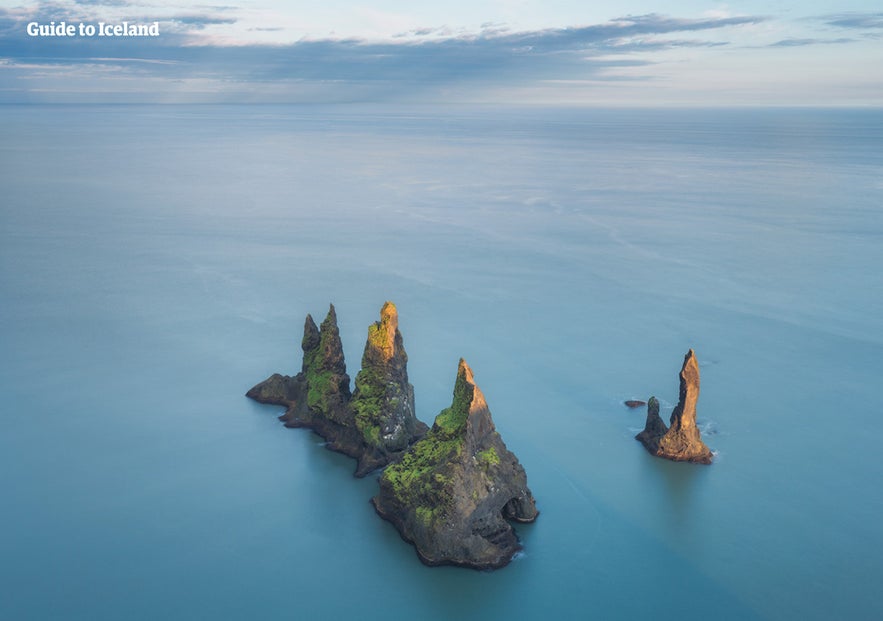
Others suggest it is the frozen imprint of a long-lost, three-masted ship, while another theory suggests Reynisdrangar is all that's left of a frozen troll after a vengeful husband froze them after learning that they’d murdered his wife. Whichever the case, Reynisdrangar is home to a wealth of nesting seabirds, including Puffins, Fulmars, and Guillemots.
Walking along the coast, travelers will also observe the hexagonal rock formations that decorate the cliffsides running along the length of Reynisfjara, known as Gardar.
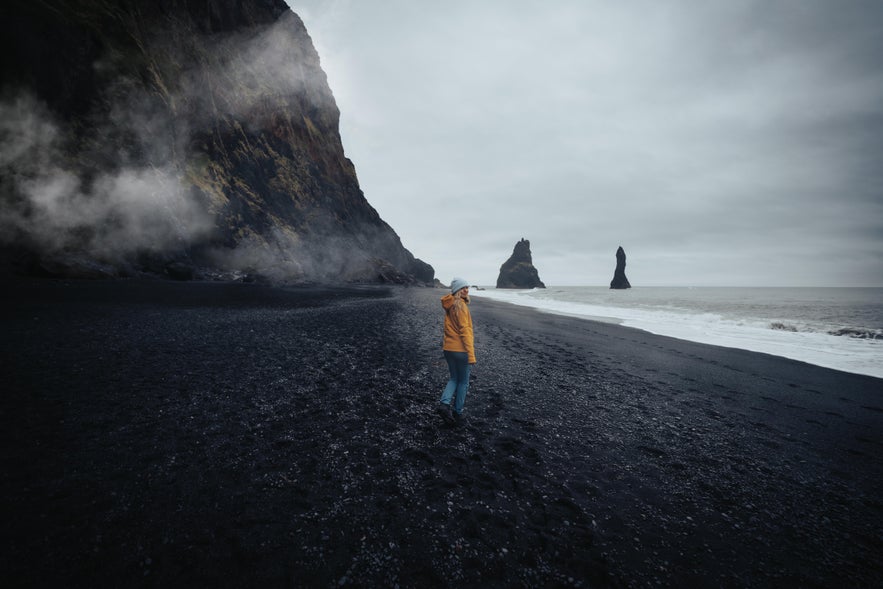 Reynisfjara beach is a breathtaking destination, but it’s important to approach it with caution. The beach is known for its powerful and unpredictable waves, often referred to as “Sneaker Waves” or “Rogue Waves,” which can suddenly surge up the shore.
Reynisfjara beach is a breathtaking destination, but it’s important to approach it with caution. The beach is known for its powerful and unpredictable waves, often referred to as “Sneaker Waves” or “Rogue Waves,” which can suddenly surge up the shore.
These waves, combined with Reynisfjara's strong currents and icy water, make it crucial for visitors to stay vigilant. Paying close attention to the warning signs and keeping a safe distance from the shoreline will ensure you can fully enjoy this stunning location while staying safe. A little caution goes a long way in making your visit both memorable and secure!
- Learn more about Vikings and Norse Gods in Iceland.
- Discover the Things That Can Kill You in Iceland (Plus Sand Snakes).
- See also: 8 Amazing Black Sand Beaches in Iceland.
Skaftafell Nature Reserve
Skaftafell is a preservation area located in the Oraefi region of southeast Iceland. Skaftafell was once a national park in its own right, having been established in 1967, but as of June 2008, it was incorporated into the enlarged Vatnajokull National Park.
Skaftafell was originally inhabited as a farmstead not long after the initial settlement of Iceland and was even the location for a number of administrative meetings between different Chieftains.
The Oraefajokull eruption of 1362 destroyed the community in its entirety, making the area uninhabitable for long periods of time. Since then, the area has been referred to as “the wasteland” or Oraefi in Icelandic.
Farmsteads continued to be re-established in the area. However, each was met with new challenges, ranging from the infertile soil to frequent glacial flooding and ash clouds from the nearby volcano, Grimsvotn. Farming was finally discontinued in the region in 1988.
Today, the area is known for its stunning natural beauty, including the country's tallest peak, Hvannadalshnukur, as well as the country's tallest waterfall, Morsarfoss. There's a stark contrast between the green birch-clad fertile ground right next to the enormous Vatnajokull glacier, making this one of Iceland's most popular hiking areas.
A short hike from the visitor center brings people to Svartifoss waterfall, although the most popular hikes are the glacier hikes themselves. Skaftafell also has a well-loved campsite, a welcoming visitor center, and a cozy café for travelers to enjoy.
Vatnajokull National Park
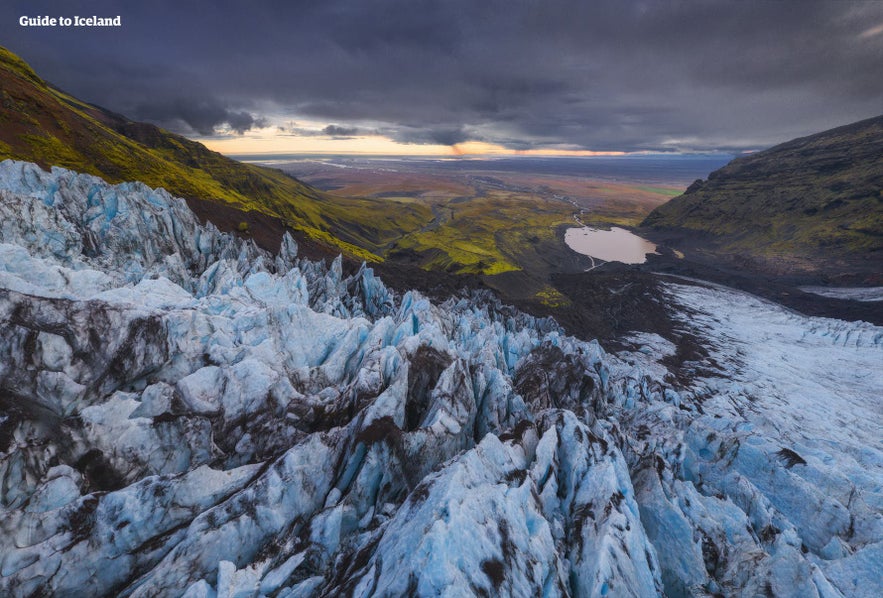
Vatnajokull is the largest glacier in both Iceland and Europe, with a total surface area of 3,127 square miles (8,100 square km). Vatnajokull reaches a maximum ice width of approximately 3,280 feet (1,000 m) and boasts over thirty different outlet glaciers, giving you some idea as to the glacier's scope.
Vatnajokull National Park covers approximately 11% of Iceland, blanketing canyons, mountains, and even volcanoes, thus proving to be an excellent example of why the country is known as the "Land of Ice and Fire."
Some of the island's most active volcanoes currently rest beneath the glacier, including Grimsvotn, Oraefajokull, and Bardarbunga. Scientists expect there to be a high level of volcanic activity in Vatnajokull over the next half-century.
Vatnajokull is just one of the three national parks in Iceland, but it is, without doubt, the largest, having absorbed both the historical Skaftafell National Park and Jokulsargljufur canyon.
The other national parks in the country are Thingvellir National Park, part of the Golden Circle route, and Snaefellsjokull National Park.
Vatnajokull National Park was established in 2008 to protect the area’s wildlife. It is so enormous that the possibilities of things to do within it are countless. However, ice caving in winter and glacier hiking all year round are the most popular activities.
Most of the park is within the Icelandic Highlands, so in order to reach more remote parts of it, a four-wheel drive car is required.
- See also: National Parks in Iceland.
- Read all about The Top 5 Places to Visit in the Icelandic Highlands.
Jokulsarlon Glacier Lagoon
Jokulsarlon glacier lagoon offers some of Iceland’s most breathtaking scenery. This serene area is defined by its tranquil icebergs, playful seal colonies, and panoramic views of the ice caps and mountains within Vatnajokull National Park. It’s easy to see why Jokulsarlon is often called “The Crown Jewel of Iceland.”
Driving here from the capital, Reykjavik, will take approximately four and half hours without stops, meaning a return trip would see you driving for approximately nine hours - but you'll surely want to make several stops along the way.
The lagoon is always increasing in size, as it is formed by the glacier calving large chunks of ice into the lagoon. Through global warming, this phenomenon is rapidly increasing, and Jokulsarlon is now Iceland's deepest lagoon, reaching a size of 6.9 square miles (18 square km) from when it first formed around 1934-1935. Since the 1970s, it has increased four times in size.
Most visitors choose to spend an evening overnight at accommodation along the South Coast, either at Hofn, Vik, or Hvolsvollur. With that being said, some do choose to make the trip in a single day, especially during the summer months when the Midnight Sun allows for nearly 24 hours of illuminated sightseeing.
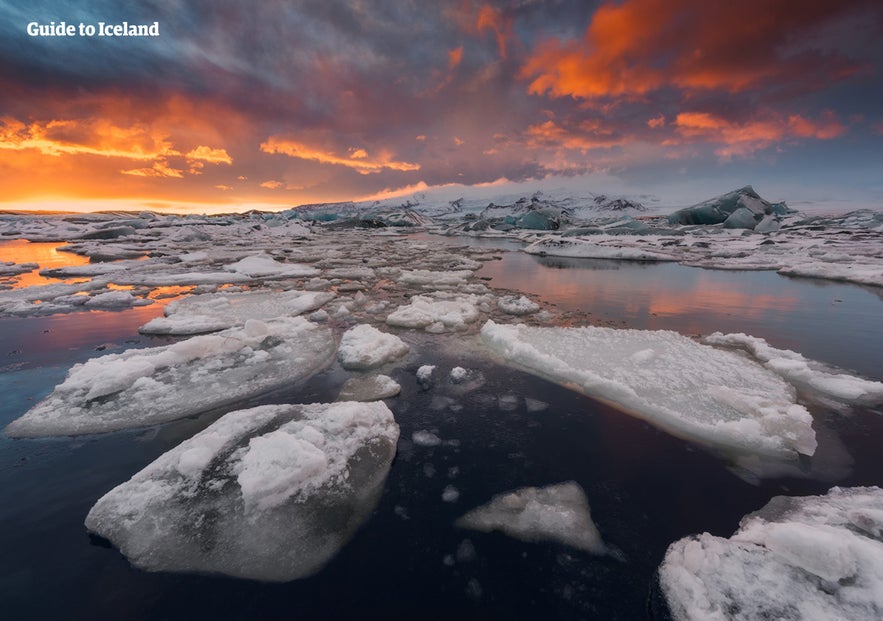
During the summer months, you can embark on an unforgettable boat tour through the breathtaking Jokulsarlon glacier lagoon, gliding among its magnificent, floating icebergs. Discover a variety of incredible tours that showcase the beauty of Jokulsarlon and its surrounding wonders.
- Discover more about Glacier Lagoons in Iceland.
Diamond Beach
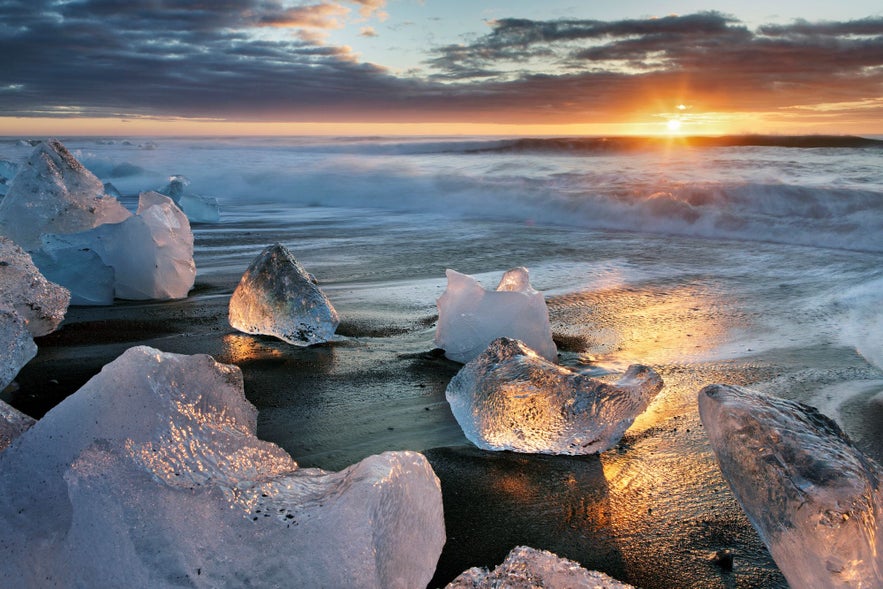 Just a five-minute walk from Jokulsarlon Glacier Lagoon lies the mesmerizing Diamond Beach, a stretch of coastline where glistening icebergs wash ashore on the jet-black volcanic sand.
Just a five-minute walk from Jokulsarlon Glacier Lagoon lies the mesmerizing Diamond Beach, a stretch of coastline where glistening icebergs wash ashore on the jet-black volcanic sand.
This captivating spot is a favorite among photographers, who are drawn to the stunning contrast between the shimmering blue ice and the dark, dramatic shoreline—a scene that’s nothing short of magical.
Thanks to the icebergs' natural formation, no photo is ever alike, and the rolling tide presents a fantastic chance to experiment with timelapse, creating fantastic and surreal pictures that perfectly capture the area's unique, ethereal nature.
Be sure to visit this magical landmark and include a stop at the stunning Diamond Beach as part of your unforgettable South Coast adventure in Iceland.
Hidden Gems Along the South Coast
The South Coast of Iceland is not just about its famous attractions—it’s also home to incredible hidden gems waiting to be discovered. Whether you’re exploring on a guided tour or driving along Route 1, these lesser-known spots offer unique experiences and breathtaking scenery that you won’t want to miss.
Here are some of the South Coast’s best-kept secrets to add to your itinerary:
Reykjadalur Valley
Translated as “Smoke Valley,” though more accurately “Steam Valley,” Reykjadalur is best known for its soothing hot river, a natural wonder created by the area’s rich geothermal activity.
However, the valley itself is just as remarkable. Its lush green hillsides are interspersed with trickling streams and cascading waterfalls and dotted with numerous hot pools and geothermal springs, making it a true haven for nature lovers.
Reykjadalur is located near the charming town of Hveragerdi, home to about 2,500 friendly residents who are always happy to help visitors find their way. Just a 40-minute drive southwest of Reykjavik, Hveragerdi is the perfect gateway to this stunning geothermal paradise.
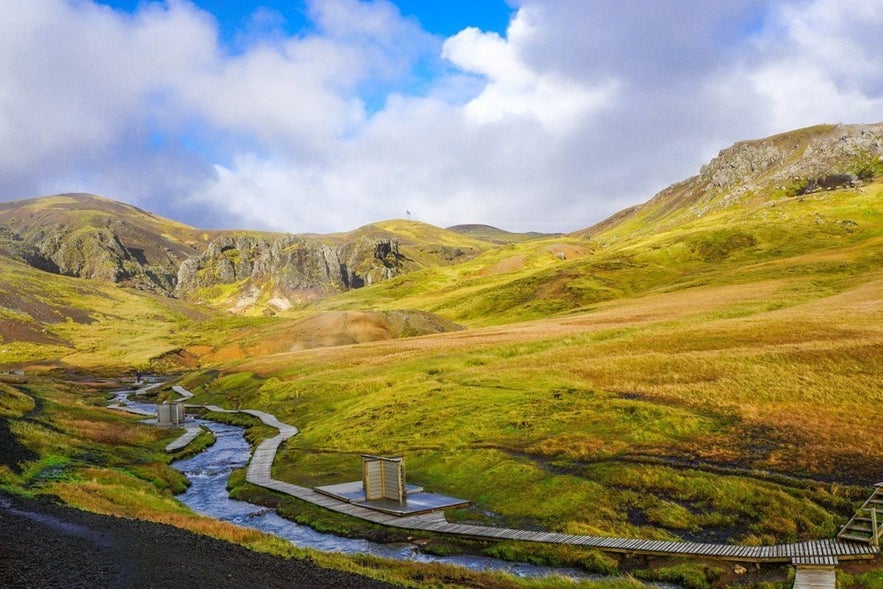 After reaching Hveragerdi, visitors will drive straight through the town until they arrive at the gravel road that leads up to Reykjadalur valley.
After reaching Hveragerdi, visitors will drive straight through the town until they arrive at the gravel road that leads up to Reykjadalur valley.
Cars are parked at the end of this gravel road, from where guests hike for 2 miles (3 km) uphill until they reach the first areas for bathing. Note that different sections of the river come out at different temperatures, so walk up and down a little to find the most comfortable spot for you.
A bus goes to Hveragerdi but not to the parking area from where the hike starts, so the best way to get here is by renting a car and joining a tour, such as this relaxing four-hour hike to Reykjadalur Valley from Hveragerdi.
- See also: Top 9 Things to Do in Hveragerdi.
Seljavallalaug Outdoor Pool
Just 14.3 miles (23 km) east of the iconic Seljalandsfoss waterfall lies one of the South Coast’s hidden gems: the Seljavallalaug pool. The pool was constructed in 1923 and is one of Iceland’s oldest swimming pools, a piece of the country’s history.
Once Iceland’s largest swimming pool, measuring 32.8 feet (10 m) wide and 82 feet (25 m) long, Seljavallalaug held the title until 1936. Despite its modest size by modern standards, this scenic pool remains a beloved stop along the South Coast—and it’s free to enter.
Visitors should note that bathing in the pool is at their own risk, as the water, fed by natural trickles from the mountainside forming one of its walls, is lukewarm at best. Still, Seljavallalaug’s unique charm and tranquil setting make it a memorable detour for those exploring the region.
Many visitors pay a little too close attention to the strange green shade the pool water often takes, a result of the algae that grows on the pool’s sides and bottoms.
Visitors are required to take all trash with them from the site and leave nothing behind. There are no showers or bathrooms on-site, but a small house where visitors can seek shelter to change clothes, and that as well is up to visitors to leave neat and tidy.
Getting there requires you to take a left turn off the Ring Road onto Road 242 until you come to a parking lot. From the parking lot, there's an additional 15-20 minute unpaved walk to reach the pool.
- See also: Best Swimming Pools in Iceland.
DC-3 Plane Wreck in Solheimasandur

For many years, the US Navy DC-3 Plane Wreck sat abandoned to the elements. The result of a fuel failure in 1973, the aircraft crashed into the black sand desert of Solheimasandur, located between Hvolsvollur and the fishing village of Vik i Myrdal. Thankfully, there was no loss of life in the incident.
It has sat there ever since, exposed and jagged, creating a stark contrast, not just with its peeling white paint to the dark, flat, volcanic earth of Solheimasandur but to its sheer artifice when compared to the open, untouched nature that has become its resting place.
- See also: The abandoned DC plane on Sólheimasandur.
Given the plane’s presence since the early seventies, and considering that Iceland’s tourism boom did not officially kick off until 2011, some Icelanders are only now beginning to accept that the DC Plane Wreck has become a makeshift visitor attraction in itself.
Until fairly recently, the wreckage was considered as something of a mess, if considered at all. It is only with foreign eyes that the wreckage has become a real point of interest.
To get there, you will need to put in a bit of effort. The plane can not be seen from the Ring Road, and it's illegal to drive to it.
The best way to visit the DC-3 plane wreck is by joining an exciting ATV tour starting from the Myrdalsjokull glacier base, offering both adventure and convenience. Alternatively, you can take a shuttle directly to the plane wreck site, saving yourself the challenging and lengthy walk to this iconic location.
Fjadrargljufur Canyon
Fjadrargljufur Canyon holds a 1.2-mile (2 km) long river in South Iceland and is approximately 62 feet (100 m) deep, with steep walls and narrow pathways. Fjadrargljufur, notoriously unpronounceable for foreigners, is said as [Fyath-raor-glyu-fur].
Fjadrargljufur canyon has changed a lot over the nine thousand years it has existed; today, guests can explore the feature either from the walking path above the canyon or actually inside of it (though this will require some wading).
The bedrock of Fjadrargljufur is palagonite, dating back to cool periods during the last Ice Age, approximately 2 million years ago. The canyon has taken on its strange and winding shape due to the river Fjadra, which begins at the mountain Geirlandshraun.
Visitors are urged to respect the path that winds itself on top of the canyon, as stepping off it damages the delicate grass and moss found there.
- See also: Top 11 Amazing Canyons in Iceland.
Dverghamrar (“Dwarf Cliffs”)
 Photo from Wikimedia, Creative Commons, by JD554. No edits were made.
Photo from Wikimedia, Creative Commons, by JD554. No edits were made.
Dverghamrar (“Dwarf Cliffs”) is an area of hexagonal basalt columns found in South Iceland, approximately 6 miles (10 km) east of Kirkjubaejarklaustur. Dverghamrar is a protected national monument.
Dverghamrar is an excellent example of how mysterious and puzzling Icelandic nature can be, a fact driven home by the attraction's mythological name. According to folklore, Dverghamrar was once the home of dwarves, elves, hidden folk, and all other supernatural beings.
- See also: Folklore in Iceland.
Charming Towns to Visit on the South Coast
The South Coast of Iceland is dotted with charming towns that provide a window into the region’s rich culture and history. These welcoming stops are ideal for taking a break from the road, savoring delicious local cuisine, relaxing in geothermal pools, or discovering cozy accommodations.
Here are some must-visit towns to explore along the South Coast:
Selfoss New Old Town
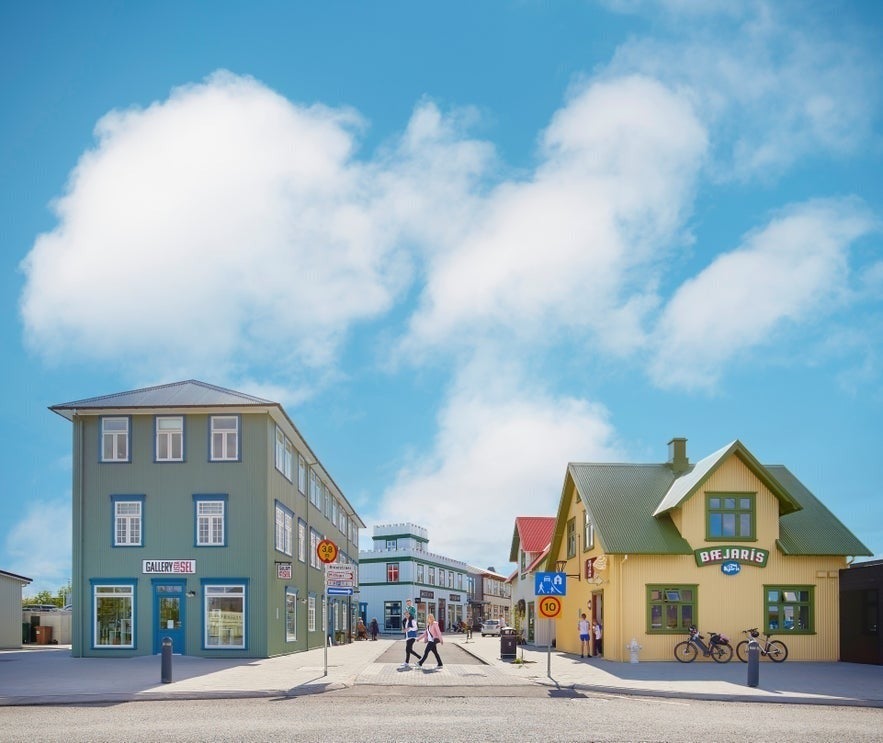 Selfoss is the largest town on the South Coast of Iceland and a popular stop while exploring the region. You'll pass through it as you drive along the Ring Road, and it's an easy addition to any Golden Circle itinerary. It's a great place for lunch or dinner on your travels, but it's also an attraction in its own right!
Selfoss is the largest town on the South Coast of Iceland and a popular stop while exploring the region. You'll pass through it as you drive along the Ring Road, and it's an easy addition to any Golden Circle itinerary. It's a great place for lunch or dinner on your travels, but it's also an attraction in its own right!
The Selfoss Center, known as the New Old Town, has restaurants, cafés, bars, shops, and the popular Skyrland Exhibition, all of which make for a great addition to your day of exploring. It features many historic Icelandic houses from all around the country that don't exist anymore and have been rebuilt to create a new picturesque town center.
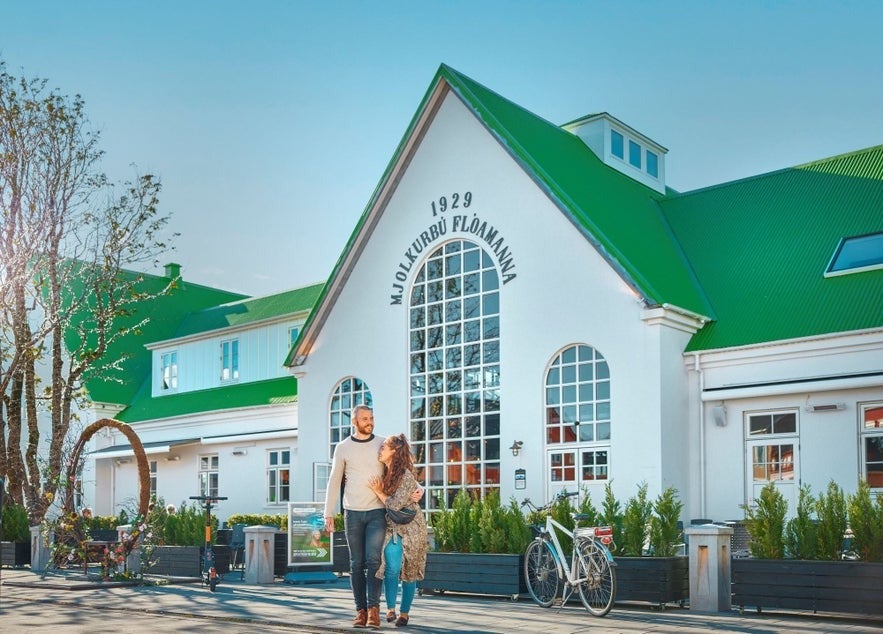 At the heart of the Selfoss Center is the Old Dairy Food Hall, located in a beautiful and historic dairy factory. It features diverse restaurants and bars, making it the perfect spot for a casual, quick, and tasty meal.
At the heart of the Selfoss Center is the Old Dairy Food Hall, located in a beautiful and historic dairy factory. It features diverse restaurants and bars, making it the perfect spot for a casual, quick, and tasty meal.
If you want a sit-down restaurant experience in Selfoss, there are also multiple options in New Old Town. One of the best restaurants is Mar Seafood, where you can enjoy fresh local fish in a very charming setting inspired by the ocean. They specialize in delicious fish pans, with generous portions perfect for sharing.
Take the chance to browse the charming shops in the area and enjoy the lively atmosphere. The town center is a great addition to any self-drive tours of the South Coast or Golden Circle. You can also find great accommodations in Selfoss to serve as a base while you explore the area’s top sights!
- Check out the Top 8 Things to Do in Selfoss.
Vestmannaeyjar (Westman Islands)
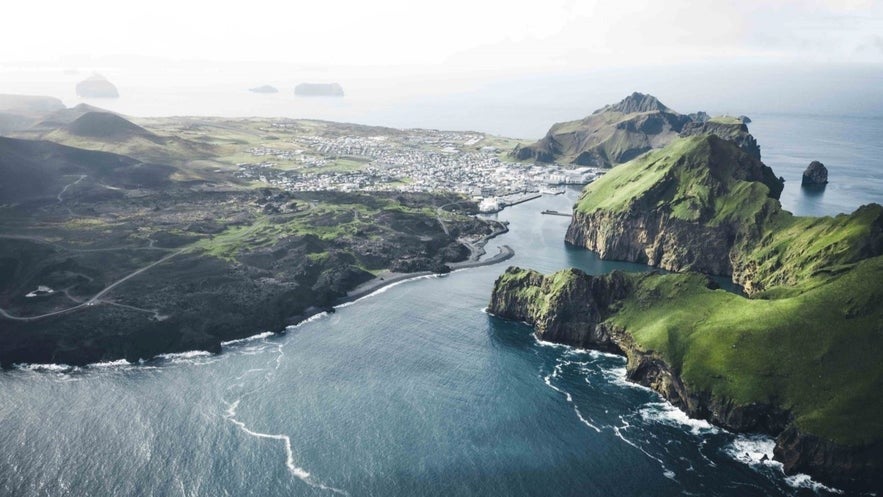
Vestmannaeyjar, or the Westman Islands, is an archipelago found off the South Coast of Iceland. The name alludes to the area's first settlers, Irish monks, or "Men from the West."
All in all, Vestmannaeyjar is comprised of 15 islands, as well as around 30 sea stacks and skerries, and are thought to have formed 10,000-12,000 years ago, making them quite young in geological terms.
The largest island, Heimaey, is the only one within the archipelago that is inhabited, currently boasting a population of approximately 4600 people. The other islands are either completely untouched by human hand or sport a solitary hunting cabin, only taking visitors in the warm summer months.
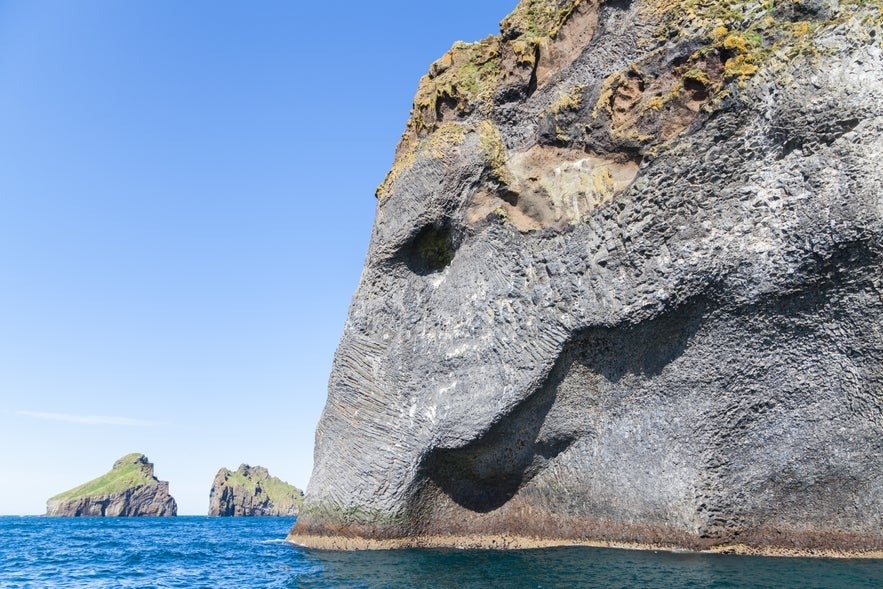
One particular draw that attracts guests to the Westman Islands is its natural biodiversity. Here, you'll find every one of Iceland's seabird species, including Guillemots, Skuas, Arctic Terns, Puffins, Icelandic Gulls, and Kittiwakes.
Thanks to the area's unique microclimate, millions of birds nest on the islands' cliffs each spring, departing again at the end of summer. The puffin, a key part of this vibrant birdlife, has even been officially adopted as the symbol of Vestmannaeyjar. You can experience this incredible wildlife up close by joining a scenic one-hour boat tour from Heimaey Harbor.
In order to get to the Westman Islands, you can take a ferry (and bring your car if you like) from Landeyjahofn harbor. Heimaey Island is easily walkable, however, so it's not necessary to bring your car with you.
The ferry trip takes about 35 minutes one way, and it's recommended to book in advance. Alternatively, you can fly from Bakki airport, which is located right next to the harbor (a 10-minute flight).
- Discover the Top Things to Do in the Westman Islands (Vestmannaeyjar).
- Read all about Where to See Puffins in Iceland.
Vik i Myrdal Village
Vik I Myrdal is a small coastal village found on Iceland’s South Coast, often utilized as a lunch stop and souvenir shopping destination for those partaking in a sightseeing tour. Some choose to stay in Vik accommodations to enjoy what the town has to offer.
The village is home to approximately 320 people yet stands as the largest settlement in a 43-mile (70-km) radius. Because of this, Vik I Myrdal is considered an important staging post and administrative center between Skogar and the Myrdalssandur glacial plain.
Vik i Myrdal is located directly south of Myrdalsjokull glacier, meaning it is under constant threat from the Katla volcano, which sits beneath the ice cap. Katla has not erupted since 1918, which, according to scientists, means the chance of a new eruption increases with each day, although it may still take many years until the next one takes place.
- Check out The 7 Best Spots for Peace, Quiet & Silence in Iceland.
- See also: Glaciers in Iceland.
Katla volcano, one of Iceland's most powerful natural features, adds an element of intrigue to the picturesque town of Vik i Myrdal. Thanks to its elevated location, the iconic red-roofed Vik church is considered a safe haven in the unlikely event of glacial flooding.
The community is well-prepared, holding regular evacuation drills to ensure the safety of its residents. Visitors staying in Vik's hotels are informed about the volcano's history and can rest assured knowing there hasn’t been an eruption in over 100 years.
In the meantime, Katla remains quiet, offering visitors the unique opportunity to embark on year-round excursions to explore the area around the volcano. Highlights include breathtaking natural ice caves nestled within the glacier that crowns Katla, making every visit to Vik a memorable adventure.
- Learn about the Best Restaurants in Vik.
- See also: Katla Volcano Ice Caving & Glacier Hiking Tour with Transfer from Vik.
Kirkjubaejarklaustur Village
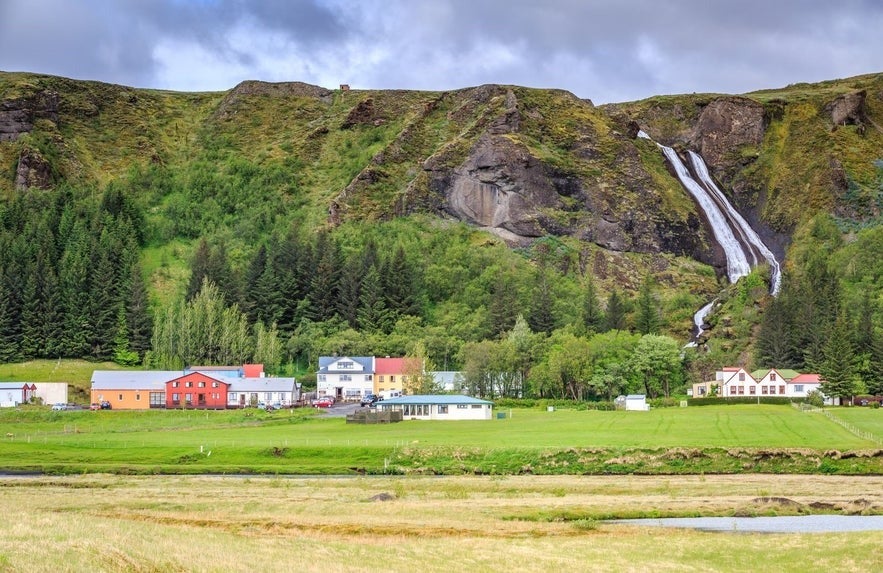
Kirkjubaejarklaustur, often known as simply “Klaustur,” is a small hamlet found on Iceland’s South Coast, to the east of Vik i Myrdal, in the municipality of Skaftarhreppur.
This village, with a population of approximately 200 people, is the only location between Vik and Hofn where it is possible to utilize local amenities, including a petrol station, supermarket, restaurants, and swimming pool.
Kirkjubaejarklaustur has a long and important history in Icelandic culture. To begin with, some believe that Kirkjubaejarklaustur may have been home to Irish Monks before the Settlement of the Norsemen. Then, in 1186, a convent of Benedictine nuns was to call the village home until the Reformation in the mid-1500s.
Kirkjubaejarklaustur is surrounded by the magnificent Eldhraun, the largest lava flow in the world, which was made during the 1783-1784 eruption of Lakagigar.
The story goes that the town was saved from destruction thanks to the famous "Eldmessa" or "Fire Sermon" by the local priest, Jón Steingrímsson, who called on divine intervention, stopping the lava before it could reach the town. Today, visitors can see the 1924 memorial chapel built as a testimony to this incredible event.
- Learn about Volcanic Eruptions in Iceland: A Complete Timeline.
- See also: The Ultimate Guide to the Highlands of Iceland | Where They Are and How to Visit.
Kirkjugolf (“The Church Floor”)
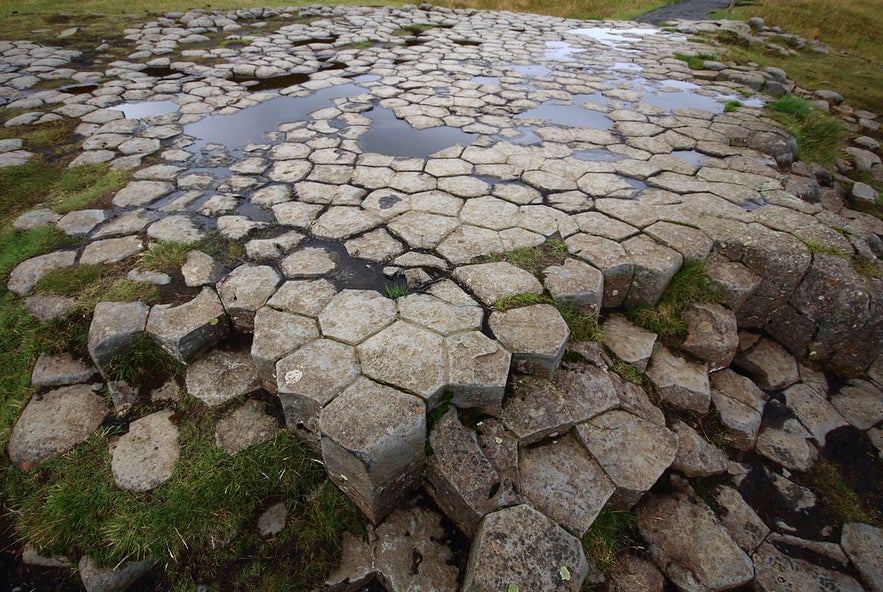
Kirkjugolf (“The Church Floor”) is an 861 square feet (80 square meters) stretch of columnar basalt rock imprinted in a field just east of Kirkjubaejarklaustur village. Despite this attraction's name, Kirkjugolf is entirely natural, resulting from cooling lava flow that becomes contracted and then cracks into a series of separate hexagonal columns.
Thus, there has never been a church on the site, merely an allusion to one. Despite this, the entire area has a history that is deeply rooted in mysticism; it is said that the town was so enchanted and sacrosanct to the early Christian settlers that pagans could not set foot there.
Hofn i Hornafirdi
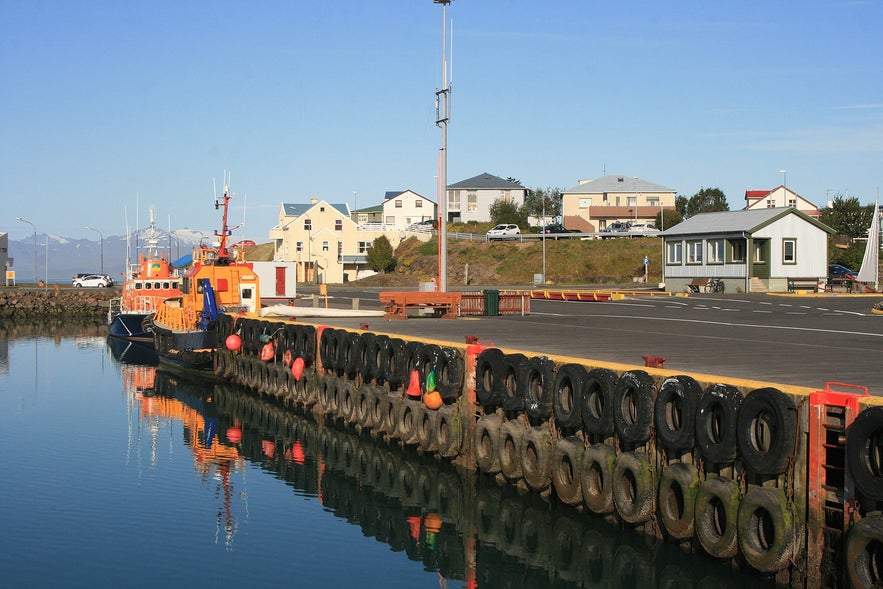 Hofn i Hornafirdi (often shortened to simply "Hofn") is a fishing village in southeast Iceland, sitting just near the Hornafjordur fjord. Between 1994 and 1998, the village was known officially as Hornafjardarbaer before taking the name it is known by today, meaning “Harbor.”
Hofn i Hornafirdi (often shortened to simply "Hofn") is a fishing village in southeast Iceland, sitting just near the Hornafjordur fjord. Between 1994 and 1998, the village was known officially as Hornafjardarbaer before taking the name it is known by today, meaning “Harbor.”
Today, the village is the second-largest urban settlement in southeast Iceland and has incredible views over the Vatnajokull glacier and the stunning Vestrahorn mountain. The surrounding landscape is characterized by shifting shoals and glacial rivers, with several small islands lying to the east of the village, such as Mikley and Krokalatur.
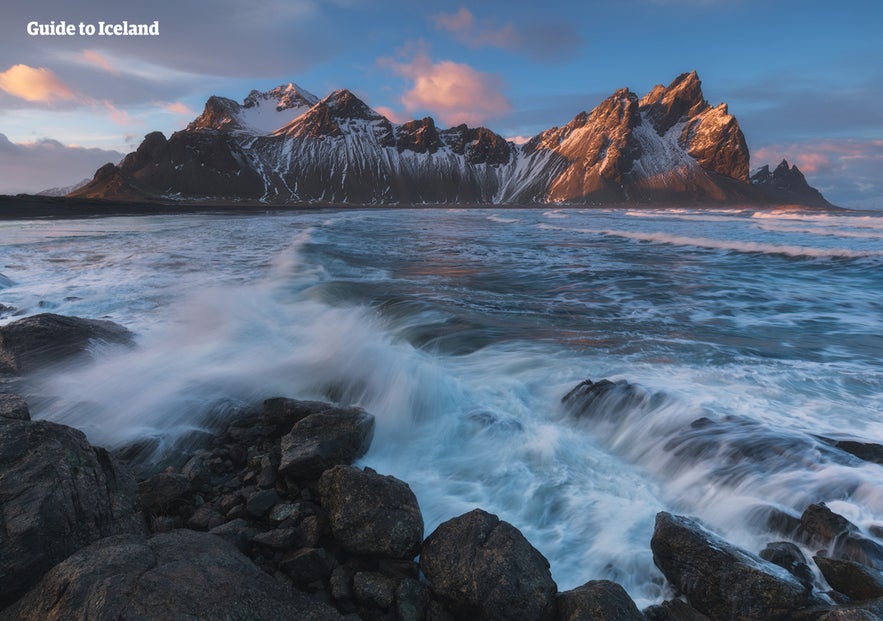
Hofn I Hornafirdi is often utilized for overnight stops for tours traveling along the South Coast, particularly those that travel as far as Jokulsarlon glacier lagoon or for those continuing east rather than returning west to the capital.
- Read all about the best places to visit in East Iceland.
- See also: The Ultimate Guide to Iceland's East Fjords.
Have you visited Iceland's scenic South Coast, and if so, what was your favorite location? Are there any handy hints that you'd like to share with future travelers to South Iceland? Make sure to leave your thoughts and queries in the comment section below.
Other interesting articles
Iceland in June | Everything You Need to Know
Find out everything you need to know about visiting Iceland in June. We help you discover what to do, where to go, and what the weather in Iceland is like in June. Embrace the midnight sun and explo...Read more
The Ultimate Guide to Iceland in August
Find out everything you need to know about visiting Iceland in August in this complete guide. Learn about what wildlife you can see, what the weather is like in Iceland in August, what sites are wor...Read moreLakes in Iceland
Which lakes are the most beautiful in Iceland and where can you find them? Read on and discover all you need to know about the natural marvels that make up Iceland's water world. Iceland is dotte...Read more

Download Iceland’s biggest travel marketplace to your phone to manage your entire trip in one place
Scan this QR code with your phone camera and press the link that appears to add Iceland’s biggest travel marketplace into your pocket. Enter your phone number or email address to receive an SMS or email with the download link.

